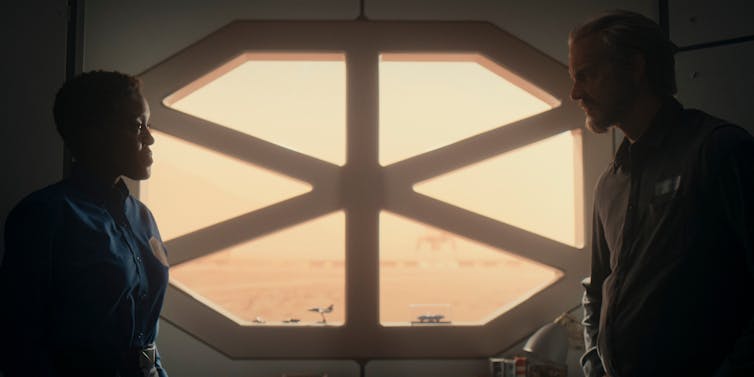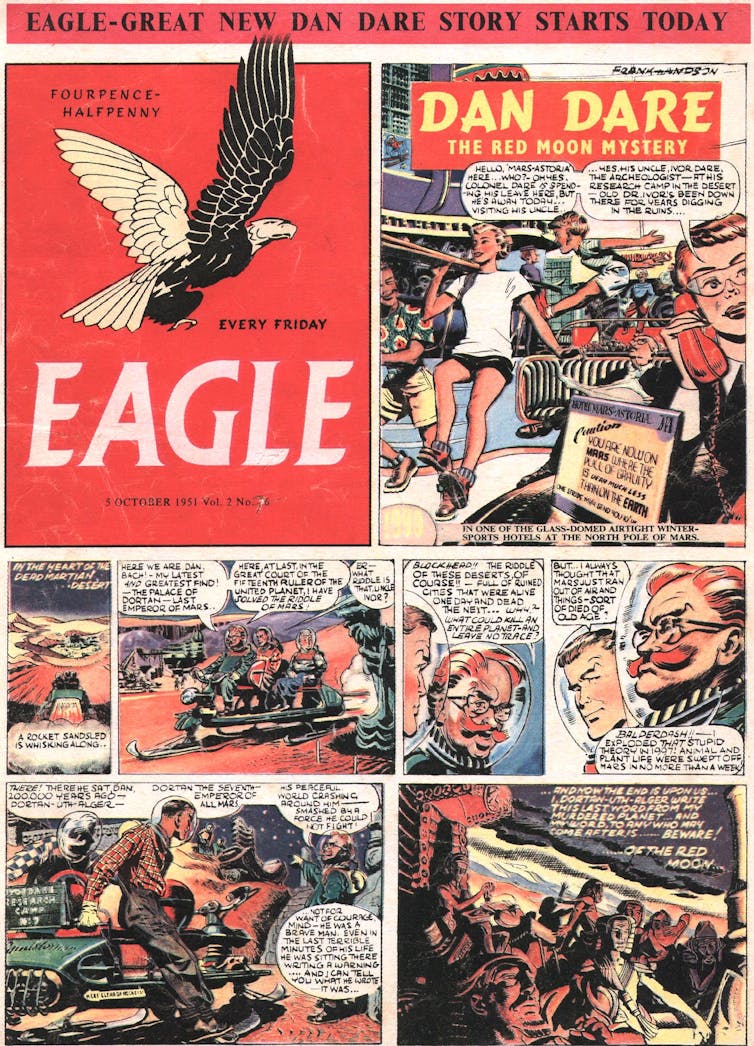
Apple TV+‘s alternate space race, For All Mankind, imagines what would have have happened if USSR cosmonauts, and not Nasa’s astronauts, had been the first to land on the Moon. Rather than the waning of interest in space that followed the Moon landings in our reality, over the four seasons of the show to date, the race has continued towards lunar and then Martian settlement.
In the latest season, the finale of which aired on January 12 2024, initial colonisation efforts on Mars have developed to the point where an international alliance supports and maintains a single large colony. Dubbed “Happy Valley”, the Martian city features an array of interconnected modules.
Tubular corridors run between bigger geodesic and half-pipe structures housing control rooms, laboratories, meeting rooms and eating and living quarters for the base commander and other higher ups. Most residents live below ground.

With its Artemis programme, Nasa plans to have humans living outside Earth’s orbit. This would including a lunar base camp, as well as a space station that circles the Moon, in the view of ultimately sending people to Mars. Quite in what structures such Martian explorers would live has long had people dreaming – and scientists experimenting.
Life on Mars?
In the early 20th century, sufficient uncertainty remained to allow for planetary romances such as the Barsoom novels of Edgar Rice Burroughs. Written between 1912 and 1946, these tell the story of a 19th-century US veteran transported to Mars, and were brought to life in the 2012 action film, John Carter. These fantasies paved the way for more serious consideration of survival on Mars as our understanding developed.
However, astronomers were already establishing that the planet’s surface was arid, cold and toxic. Long before Burroughs completed his series, it was clear that Barsoom’s great cities, open to a breathable atmosphere, could never exist.
One of the earliest stories to seriously consider the scientifically understood conditions on Mars, and the life that might result from it, was Stanley Weinbaum’s 1934 novella, A Martian Odyssey. In keeping with telescopic observations of the planet’s cold, thin air and spectra indicating a lack of both water and vegetation, this was a Mars devoid of cityscapes, but not of life. Salvaging what he can from a crashed shuttle, the protagonist treks across 800 miles of Martian landscape, encountering a variety of interesting Martian forms.
In the early 20th century, it was believed that Mars’s atmosphere was thin, but not necessarily beyond the range of human adaptability. After all, settlements on Earth exist at altitudes of up to 5,000m – where the atmospheric pressure is less than half that at the surface. Early estimates for Martian surface pressure were in this ballpark (rather than less than 1%, as we now know. Thus Weinbaum speaks of “months spent in acclimatisation chambers”, but otherwise frees his explorer (and any Mars settlement) from the needs of atmosphere management.
Going underground
By the middle of the 20th century, Earth-based observations and the first of the Mariner probe missions had removed any doubt about the hostility of Mars’s atmosphere. The cities envisaged by mid-century sci-fi writers were encased in vast protective domes. These could contain an Earth-like environment and allow humans to breathe and move freely without protective equipment.
Such domed surface cities can be found in examples ranging from childrens’ fare such as Dan Dare: Pilot of the Future, to the work of established authors including Larry Niven (see his 1966 story, How the Heroes Die). Some saw these domes as fully urbanised. Others imagined a more scattered settlement amid a managed landscape.

This dominant image of cities on Mars persists to the current day, in imagery from Mars colonisation enthusiasts including the international Mars Society and SpaceX. Research suggests, however, that as long-term habitation, a domed environment would have significant flaws.
Since the 1960s, scientific understanding of the impact of radiation on humans and their offspring has advanced. The planet lacks the protection, afforded by Earth’s thick atmosphere and its strong magnetic field, to our DNA, from a rain of ionising particles from the Sun and beyond. Smart dome materials might filter some of this, but could not protect astronauts from the cumulative effects of penetrating particles, leaving its occupants vulnerable to cancer.
As pointed out by many writers (including Niven in the story already mentioned), large domes would leave a city on Mars vulnerable to air leaks too, as well as the extreme fluctuations in day-night temperature the planet experiences (from -125C to 20C). Further, the material would be abraded over time by sandstorms so extreme, they are visible from Earth.
Instead, many researchers now consider underground or cave settlements as sites for human settlement on Mars. Here protection from temperature, radiation, sandstorms and air leaks are all provided by a thick layer of regolith (soil or rock), reducing the cumulative exposure any settlers would face.
While the red planet is now devoid of surface water, it is likely to have cave systems dating from its wetter, tectonically active youth, and – unlike Earth – its surface quakes are rare and weak. If natural caves are unavailable, tunnelling, or even using surface rock powder to make a form of Martian concrete may be good alternatives. Indeed, partly with Mars-prototyping in mind, Nasa and ESA have explored the idea of 3D printing and then burying habitation modules on the Moon, which experiences many of the same risks.
For All Mankind has been noted for its realistic physics. The production team include a NASA technical advisor.
Perhaps unsurprisingly its Happy Valley colony, descending several levels into the Martian subsurface, represents a plausible vision for future Martian cities. Contrary to the series though, underground levels might well be sought after, by real-world Martian residents, for the increased protection they provide.
Planetary settlement remains an increasingly distant prospect in our reality, but science fiction has always played a role in shaping public understanding of our planetary neighbours and in fostering enthusiasm for their exploration. Just as Burroughs’ Barsoom novel inspired the scientists working on the Mars landers of the 1960s-70s, today’s viewers of For All Mankind might include the engineers and scientists that one day bring its vision of a Martian city to fruition.
Elizabeth Stanway, Reader in Astronomy and Astrophysics, University of Warwick
This article is republished from The Conversation under a Creative Commons license. Read the original article.











